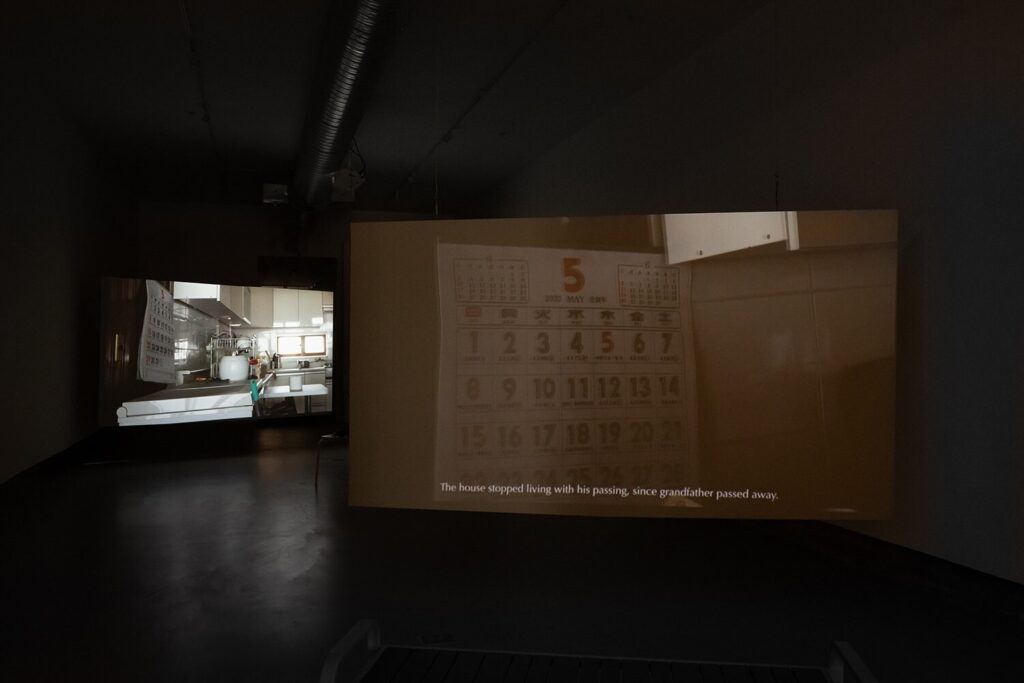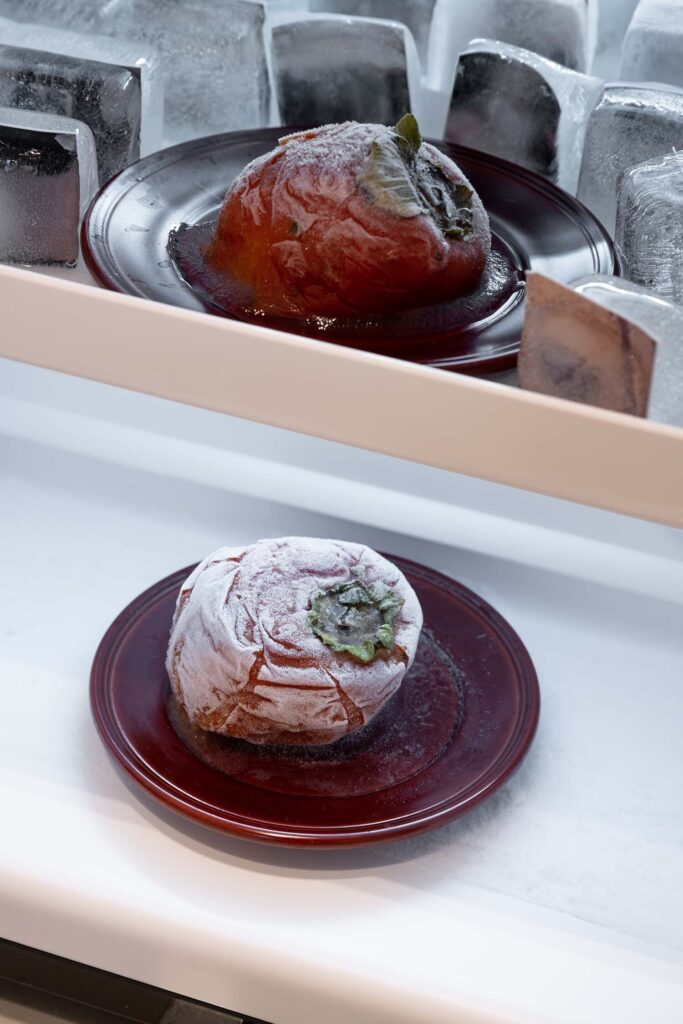Past Exhibition
when the body becomes dust and settles around you
In this exhibition, Cecilia Kim’s works are embedded with her lived experiences, including the recent passing of her grandparents.
Absence serves as the doorway that molds grief into the very foundation of home; it is a gateway for processing emotions. We are called to walk through it by entering the doors of Hamiltonian Artists and invited to a four-way conversation between video artist Cecilia Kim’s friends in her solo exhibition when the body becomes dust and settles around you (2023).

In Far from Home II (2023), four staggered television screens feature conversations that are about defining home as a concept, rather than a physical location. In this work, home is something we carry with us. It is a connection, a history, and memories: something that becomes layered with multiple movements, something that is reflected across Kim’s many lives across the continents of North America, Asia, and Europe.

In the exhibition’s central works Tidal Calling (Flow) (2023) and Tidal Calling (Ebb) (2023), Kim mirrors the tide through time. She shares that, rather than ebb and flow in English, in Korean, “Flow comes first because the water rushes in, like a ghostly memory—followed by Ebb, where the tide goes back out, taking any spiritual or ghostly remains away.” Created a year apart from her grandfather’s and grandmother’s passing, the two videos hang diagonally from each other in the center atrium of Hamiltonian Artists. Screened in conjunction, they index and deepen the visual and linguistic metaphors embedded within them. While we examine the interior environment that is punctuated by poetry in one, in the other we see her grandparents’ belongings explode and atomize. Those who leave us in the living realm are present in the dust, atmosphere, and atoms of our world. This liminal space is the threshold that gives way to Kim’s meditations on processing grief, the thawing of emotions and the revelation of memory—each careful consideration drawing our attention to closer what our loved ones leave behind.

Grief is not linear: it is a process, it is an undoing and reassembling. Grief can be beautifully haunting: a tunnel through a never-ending hallway, resembling a train car, taking us from one plane of digital existence to the next such as depicted in her video Tidal Calling (Flow). Grief is a central theme that continues to be explored in Kim’s constructed 3D world spaces. In Far from Home II (2023), Kim has studied the effect of embodying liminal spaces such as trees that cast shadows, reflective staircases, fireplaces and lamps in green grass. Grief creates a world within us.
In this post-quarantine pandemic world, dealing with grief and its lingering echoes is an ongoing process, one that an increasing number of people are willing to delve into. From grief tool-kits and guides, to poetry on processing grief, Kim’s work serves as a poignant reminder of sadness and its haunting warmth. Her poetic phrase reflects this notion: “In the air, a surprise of warmth that is everlasting that comes from not the winter of January.” This highlights the ways grief breaks into small fragments and hangs in the air when it is not spoken to or felt, with heavy and weighted feelings our avoidance can show up that results in unspoken secrets and us pretending as if that sadness did not occur. Kim’s artwork reminds us to work through the denial of grief and affirm it so that we can see it in its fullness and wade ever deeper. The emotion melting, thawing, is reflected in The last persimmon my grandfather picked (2023) that consists of a freezer, persimmon, ice, and laser print photographs.

This installation includes photos of her grandparents’ cemetery in Korea and mountains where people may come to make wishes by piling rocks at local temples. Activating the spatial sense of our bodies, the photos are hung just above eye level and remind viewers to look beyond to the larger world to hold our grief. In the freezer at our feet, we are invited to bend down and gaze at the ice cubes that over time melt and reveal images underneath such as images of family, sites of burial and wishes in the mountains. Alongside the ice cubes are persimmons that are from her grandfather’s tree that she brought from Korea to the United States, as the freezer door is opened during the gallery’s open hours, it will thaw, and upon the gallery’s closing, the persimmon will freeze again, over time, the fruit will turn into a gooey-like substance—such a clear approximated visualization of the site of grief that indexes melting, atomizing and forgetting its shape and morphing to resemble a different version of our former selves. Grief changes our bodies, our positions, and the way we see ourselves in this world.
Kim was not told of her grandfather’s passing and has shared that it was hidden from her grandmother. In both video projects, she shows an image of her grandmother and inquires to the viewer through subtitles, “She is innocent and young. Did she know?” Embodied in her reflection is vulnerability, a deep care and embrace of grief’s incapability to be fully known and the processing of grief’s ever-changing shape.
when the body becomes dust and settles around you offers a profound and immersive exploration of grief as a transformative force in our lives. Through a series of captivating installations, Kim invites viewers to traverse the threshold of absence, guiding us on a poignant journey of processing emotions and revelations of memory. As we encounter her evocative art, we are urged to embrace grief’s warmth, confront its denial, and cherish the legacy our loved ones leave behind. Through vulnerable reflections and poetic expressions, Kim’s art becomes a vessel through which we confront our shared humanity and the ever-changing shapes of grief, resonating deeply with our emotions and experiences in this post-quarantine pandemic world.
Hiba Ali is a digital artist, educator, and scholar.
This essay is published in partnership with East City Art to promote critical writing on visual art in the greater DC area.
Past Exhibition
In this exhibition, Cecilia Kim’s works are embedded with her lived experiences, including the recent passing of her grandparents.